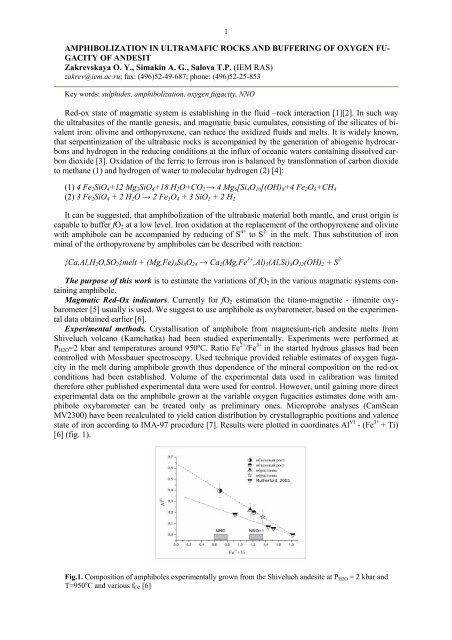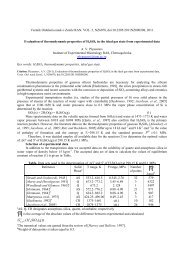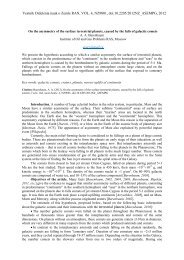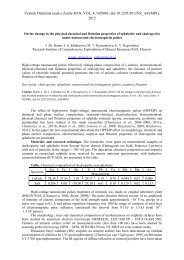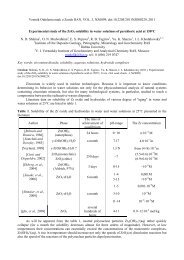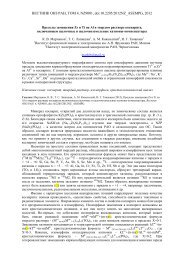Amphibolization in ultramafic rocks and buffering of oxygen fugacity ...
Amphibolization in ultramafic rocks and buffering of oxygen fugacity ...
Amphibolization in ultramafic rocks and buffering of oxygen fugacity ...
You also want an ePaper? Increase the reach of your titles
YUMPU automatically turns print PDFs into web optimized ePapers that Google loves.
1<br />
AMPHIBOLIZATION IN ULTRAMAFIC ROCKS AND BUFFERING OF OXYGEN FU-<br />
GACITY OF ANDESIT<br />
Zakrevskaya O. Y., Simak<strong>in</strong> A. G., Salova T.P. (IEM RAS)<br />
zakrev@iem.ac.ru; fax: (496)52-49-687; phone: (496)52-25-853<br />
Key words: sulphides, amphibolization, <strong>oxygen</strong> <strong>fugacity</strong>, NNO<br />
Red-ox state <strong>of</strong> magmatic system is establish<strong>in</strong>g <strong>in</strong> the fluid –rock <strong>in</strong>teraction [1][2]. In such way<br />
the ultrabasites <strong>of</strong> the mantle genesis, <strong>and</strong> magmatic basic cumulates, consist<strong>in</strong>g <strong>of</strong> the silicates <strong>of</strong> bivalent<br />
iron: oliv<strong>in</strong>e <strong>and</strong> orthopyroxene, can reduce the oxidized fluids <strong>and</strong> melts. It is widely known,<br />
that serpent<strong>in</strong>ization <strong>of</strong> the ultrabasic <strong>rocks</strong> is accompanied by the generation <strong>of</strong> abiogenic hydrocarbons<br />
<strong>and</strong> hydrogen <strong>in</strong> the reduc<strong>in</strong>g conditions at the <strong>in</strong>flux <strong>of</strong> oceanic waters conta<strong>in</strong><strong>in</strong>g dissolved carbon<br />
dioxide [3]. Oxidation <strong>of</strong> the ferric to ferrous iron is balanced by transformation <strong>of</strong> carbon dioxide<br />
to methane (1) <strong>and</strong> hydrogen <strong>of</strong> water to molecular hydrogen (2) [4]:<br />
(1) 4 Fe 2 SiO 4 +12 Mg 2 SiO 4 +18 H 2 O+CO 2 → 4 Mg 6 [Si 4 O 10 ](OH) 8 +4 Fe 2 O 3 +CH 4<br />
(2) 3 Fe 2 SiO 4 + 2 H 2 O → 2 Fe 3 O 4 + 3 SiO 2 + 2 H 2<br />
It can be suggested, that amphibolization <strong>of</strong> the ultrabasic material both mantle, <strong>and</strong> crust orig<strong>in</strong> is<br />
capable to buffer fO 2 at a low level. Iron oxidation at the replacement <strong>of</strong> the orthopyroxene <strong>and</strong> oliv<strong>in</strong>e<br />
with amphibole can be accompanied by reduc<strong>in</strong>g <strong>of</strong> S 4+ to S 2- <strong>in</strong> the melt. Thus substitution <strong>of</strong> iron<br />
m<strong>in</strong>al <strong>of</strong> the orthopyroxene by amphiboles can be described with reaction:<br />
{Ca,Al,H 2 O,SO 2 }melt + (Mg,Fe) 8 Si 8 O 24 → Ca 2 (Mg,Fe 3+ ,Al) 5 (Al,Si) 8 O 22 (OH) 2 + S 2-<br />
The purpose <strong>of</strong> this work is to estimate the variations <strong>of</strong> fO 2 <strong>in</strong> the various magmatic systems conta<strong>in</strong><strong>in</strong>g<br />
amphibole.<br />
Magmatic Red-Ox <strong>in</strong>dicators. Currently for fO 2 estimation the titano-magnetite - ilmenite oxybarometer<br />
[5] usually is used. We suggest to use amphibole as oxybarometer, based on the experimental<br />
data obta<strong>in</strong>ed earlier [6].<br />
Experimental methods. Crystallisation <strong>of</strong> amphibole from magnesium-rich <strong>and</strong>esite melts from<br />
Shiveluch volcano (Kamchatka) had been studied experimentally. Experiments were performed at<br />
Р Н2О =2 kbar <strong>and</strong> temperatures around 950ºС. Ratio Fe 2+ /Fe 3+ <strong>in</strong> the started hydrous glasses had been<br />
controlled with Mossbauer spectroscopy. Used technique provided reliable estimates <strong>of</strong> <strong>oxygen</strong> <strong>fugacity</strong><br />
<strong>in</strong> the melt dur<strong>in</strong>g amphibole growth thus dependence <strong>of</strong> the m<strong>in</strong>eral composition on the red-ox<br />
conditions had been established. Volume <strong>of</strong> the experimental data used <strong>in</strong> calibration was limited<br />
therefore other published experimental data were used for control. However, until ga<strong>in</strong><strong>in</strong>g more direct<br />
experimental data on the amphibole grown at the variable <strong>oxygen</strong> fugacities estimates done with amphibole<br />
oxybarometer can be treated only as prelim<strong>in</strong>ary ones. Microprobe analyses (CamScan<br />
MV2300) have been recalculated to yield cation distribution by crystallographic positions <strong>and</strong> valence<br />
state <strong>of</strong> iron accord<strong>in</strong>g to IMA-97 procedure [7]. Results were plotted <strong>in</strong> coord<strong>in</strong>ates Al VI - (Fe 3+ + Ti)<br />
[6] (fig. 1).<br />
Fig.1. Composition <strong>of</strong> amphiboles experimentally grown from the Shiveluch <strong>and</strong>esite at Р Н2О = 2 kbar <strong>and</strong><br />
Т=950 о С <strong>and</strong> various f O2 [6]
2<br />
Fig.2. The diagram <strong>of</strong> the <strong>oxygen</strong> <strong>fugacity</strong> estimated us<strong>in</strong>g the analyses <strong>of</strong> amphiboles from <strong>ultramafic</strong><br />
<strong>in</strong>clusions <strong>in</strong> Shiveluch <strong>and</strong>esites<br />
Natural material. Below we present results <strong>of</strong> the study <strong>of</strong> ultrabasic xenoliths from the Shiveluch<br />
<strong>and</strong>esites. Studied samples were represented by shp<strong>in</strong>el-bear<strong>in</strong>g peridotites conta<strong>in</strong><strong>in</strong>g oliv<strong>in</strong>e (~ 20-50<br />
%), ortopyroxen (~ 30-50 %), cl<strong>in</strong>opyroxen (~ 5-10 %), amphiboles (magmatic hornblende) (~10-30<br />
%), plagioclase (~5 %), glass, also <strong>in</strong>significant quantities <strong>of</strong> accessory m<strong>in</strong>erals were present: apatite,<br />
sp<strong>in</strong>el (ma<strong>in</strong>ly chromsp<strong>in</strong>el), <strong>and</strong> occasionally sulphides (
3<br />
characterized by homogeneous f O2 conditions opposite to the strongly variable oxidtation state <strong>of</strong><br />
Shiveluch <strong>and</strong>esites.<br />
Fig.3. The results diagram <strong>of</strong> the <strong>oxygen</strong> <strong>fugacity</strong> estimated us<strong>in</strong>g the analyses <strong>of</strong> amphiboles from<br />
<strong>ultramafic</strong> <strong>in</strong>clusions <strong>in</strong> Shiveluch <strong>and</strong>esite <strong>and</strong> from published data<br />
In the paper by McGuire [11] analyses <strong>of</strong> mantle (as <strong>in</strong>terpreted by author) xenoliths from California<br />
are presented. Analyses <strong>of</strong> the amphiboles from two samples lay down on two trends (the Fig. see).<br />
Both l<strong>in</strong>ear trends are crossed with axis Fe 3 + + Ti <strong>in</strong> a po<strong>in</strong>t around 1.8 (apfe), as well as the experimental<br />
trend. One group <strong>of</strong> po<strong>in</strong>ts is <strong>in</strong> agreement with pressure around 2 kbar. Another group corresponds<br />
to a higher pressure. Tak<strong>in</strong>g <strong>in</strong>to account data obta<strong>in</strong>ed at 14 kbar [6] it can be estimated approximately<br />
<strong>in</strong> the range <strong>of</strong> 4-7 kbar. In both cases <strong>oxygen</strong> <strong>fugacity</strong> is high enough (NNO-NNO+0.5).<br />
That can testify about crustal orig<strong>in</strong> <strong>of</strong> amphiboles. The ultrabasic material can be a product <strong>of</strong> the <strong>in</strong>trachamber<br />
differentiation.<br />
Conditions <strong>of</strong> magmatic amphibole crystallization <strong>in</strong> equilibrium with sulphides can be evaluated<br />
us<strong>in</strong>g analyses <strong>of</strong> the cortl<strong>and</strong>ites (the ultrabasic <strong>rocks</strong> conta<strong>in</strong><strong>in</strong>g magmatic amphibole) reported <strong>in</strong><br />
[12]. These data relates to the magmatic sulphide ores associated with basic-ultrabasic <strong>in</strong>trusion located<br />
<strong>in</strong> Central Range <strong>of</strong> Kamchatka. The composition <strong>of</strong> amphibole from the discussed <strong>rocks</strong> reflects<br />
f O2 ≈ NNO/NNO-1 (fig. 3).<br />
Very reduced amphiboles are characterized <strong>in</strong> [13]. These amphiboles were found <strong>in</strong> the granophyric<br />
<strong>in</strong>clusions <strong>in</strong> basalts <strong>of</strong> the Karymsky volcano (Kamchatka). Amphibole composition corresponds<br />
to f O2 ≈ NNO-1/NNO-2. Probably, reduced conditions <strong>in</strong> the parent (for granophyric <strong>in</strong>clusions)<br />
dacites are caused by their close connection with basalts, <strong>in</strong>stead <strong>of</strong> <strong>and</strong>esites.<br />
Based on the considered above data, it is possible to expla<strong>in</strong> practically full absence <strong>of</strong> sulphides <strong>in</strong><br />
amphibolized nodules from Shiveluch by oxidized state <strong>of</strong> sulphur <strong>in</strong> the melt. Data <strong>of</strong> other authors<br />
[11][13] seem to reflect more reduced melt character, which can be compatible with the prevalence <strong>of</strong><br />
sulfide sulfur <strong>in</strong> the magma. The composition <strong>of</strong> the amphiboles from cortl<strong>and</strong>ite [12] corresponds to<br />
f O2 around NNO/NNO-1 match<strong>in</strong>g well with the associated Cu-Ni ores. Then, consider<strong>in</strong>g the aforesaid,<br />
it is possible to make an assumption on the presence <strong>of</strong> an appreciable amount <strong>of</strong> a sulphides <strong>in</strong><br />
the <strong>rocks</strong> described <strong>in</strong> [13].<br />
Conclusions. On the basis <strong>of</strong> the aforesaid, we can conclude that, at the reaction <strong>of</strong> the mantle <strong>and</strong><br />
crustal ultrabasic modules with <strong>and</strong>esites, magma is reduced, <strong>in</strong> a limit<strong>in</strong>g case <strong>of</strong> the high ratio <strong>of</strong> the<br />
ultrabasic material to <strong>and</strong>esite(r>> 1), approximately to the level <strong>of</strong> NNO/NNO+0.5. This <strong>oxygen</strong> <strong>fugacity</strong><br />
level is somewhat higher, than threshold one for the sulphate- sulfidic sulfur transition at the<br />
low pressure (up to 2-3 kbar).<br />
References<br />
1. Marakushev A.A., Perchuk L.L. Thermodynamic model <strong>of</strong> the Earth's fluid regime // Essays on<br />
physico-chemical petrology // M.: Nauka. 1974 (<strong>in</strong> Russian).
4<br />
2. Letnikov F.A., Karpov I.K., Kiselev A.I., Shk<strong>and</strong>ry B.O. Fluid regime <strong>of</strong> the crust <strong>and</strong> upper mantle<br />
// M.: Nauka. 1977. P. 214 (<strong>in</strong> Russian).<br />
3. Hosgormez H., Etiope G., Yalç<strong>in</strong> M.N. New evidence for a mixed <strong>in</strong>organic <strong>and</strong> organic orig<strong>in</strong> <strong>of</strong><br />
the Olympic Chimaera fire (Turkey): a large onshore seepage <strong>of</strong> abiogenic gas // Ge<strong>of</strong>luids. 2008. 8. P.<br />
263-273.<br />
4. Soroht<strong>in</strong> O.G., Le<strong>in</strong> A.Yu., Balanyuk I.E. Thermodynamics <strong>of</strong> hydrothermal oceanic systems <strong>and</strong><br />
abiogenic generation <strong>of</strong> methane // Oceanology. 2001. V. 41. No 6. P.. 898-909 (<strong>in</strong> Russian).<br />
5. Andersen, D.J., L<strong>in</strong>dsley, D.H. New (<strong>and</strong> f<strong>in</strong>al!) models for the Ti-magnetite/ilmenite geothermometer<br />
<strong>and</strong> <strong>oxygen</strong> barometer. 1985, EOS 66, p. 416<br />
6. Simak<strong>in</strong> A.G., Salova T.P., Babansky A.D. Growth <strong>of</strong> amphibole from <strong>and</strong>esite melt Shiveluch<br />
volcano // Petrology. 2009 (<strong>in</strong> press) (<strong>in</strong> Russian).<br />
7. Leake B.E., Wooley A.R., Arps C.E.S., Birch W.D., Gilbert M.C., Grice J.D., Hawthrone F.C.,<br />
Kato A., Kisch H.J., Krivovichev V.G., L<strong>in</strong>thout K., Laird J., M<strong>and</strong>ar<strong>in</strong>o J.A., Maresch W.V., Nickel<br />
E.H., Rock N.M.S., Schumacher J.C., Smith D.C., Stephensen N.C.N., Ungaretti L., Whittaker E.J.W.,<br />
Youzhi G. Nomenclature <strong>of</strong> amphiboles: Report <strong>of</strong> the Subcommittee on Amphiboles <strong>of</strong> the International<br />
m<strong>in</strong>eralogical Association, Commission on New M<strong>in</strong>erals <strong>and</strong> M<strong>in</strong>eral Names //American M<strong>in</strong>eralogist.<br />
1997. V. 82. P. 1019-1037.<br />
8. Jugo P.J., Luth R.W., Richards J.P. An experimental study <strong>of</strong> the sulfur content <strong>in</strong> basaltic melts<br />
saturated with immiscible sulfide or sulfate liquids at 1300 o C <strong>and</strong> 1.0 GPa // J. Petrol. 2005. 46 P. 783-<br />
798.<br />
9. Robert Moretti, Don R. Baker. Model<strong>in</strong>g the <strong>in</strong>terplay <strong>of</strong> fO 2 <strong>and</strong> fS 2 along the FeS-silicate melt<br />
equilibrium // Chemical Geology. 2008. 256. P. 286-298.<br />
10. Sato H., Holtz F., Beherenz H., Botcharnikov R., Nakada S. Experimental Petrology <strong>of</strong> the<br />
1991-1995 Unzen Dacite, Japan. Part II: Cl/OH Partition<strong>in</strong>g between Hornblende <strong>and</strong> Melt <strong>and</strong> its Implications<br />
for the Orig<strong>in</strong> <strong>of</strong> Oscillatory Zon<strong>in</strong>g <strong>of</strong> Hornblende Phenocrysts // J. Petrology. 2005. V. 46.<br />
No 2. P. 339-354.<br />
11. Anne V. McGuire, M. Darby Dyar, Jane E. Nielson. Metasomatic oxidation <strong>of</strong> upper mantle<br />
peridotite // Contributions to M<strong>in</strong>eralogy <strong>and</strong> Petrology. 109. 1991. P. 252-264.<br />
12. Konnikov E.G., Vasyukova O.N. Composition <strong>of</strong> fluid <strong>in</strong>clusions from <strong>in</strong>trusive <strong>rocks</strong> <strong>of</strong> the<br />
norite-cortl<strong>and</strong>ite complex, Kamchatka // Geology <strong>of</strong> Ore Deposits. 2007. V. 49. No 3. P. 256-267 (<strong>in</strong><br />
Russian).<br />
13. Izbekov, P.E. The 1996 eruption <strong>of</strong> Karymsky Volcano, Kamchatka: Detailed petrological<br />
study <strong>of</strong> a s<strong>in</strong>gle basalt-triggered eruption cycle // Doctoral dissertation from University <strong>of</strong> Alaska,<br />
Fairbanks. 2002. P. 220.<br />
Electronic Scientific Information Journal “Vestnik Otdelenia nauk o Zemle RAN” № 1(27)′2009<br />
ISSN 1819 – 6586<br />
Informational Bullet<strong>in</strong> <strong>of</strong> the Annual Sem<strong>in</strong>ar <strong>of</strong> Experimental M<strong>in</strong>eralogy, Petrology <strong>and</strong> Geochemistry – 2009<br />
URL: http://www.scgis.ru/russian/cp1251/h_dgggms/1-2009/<strong>in</strong>formbul-1_2009/magm-13e.pdf<br />
Published on July, 1, 2009<br />
© Vestnik Otdelenia nauk o Zemle RAN, 1997-2009<br />
All rights reserved


